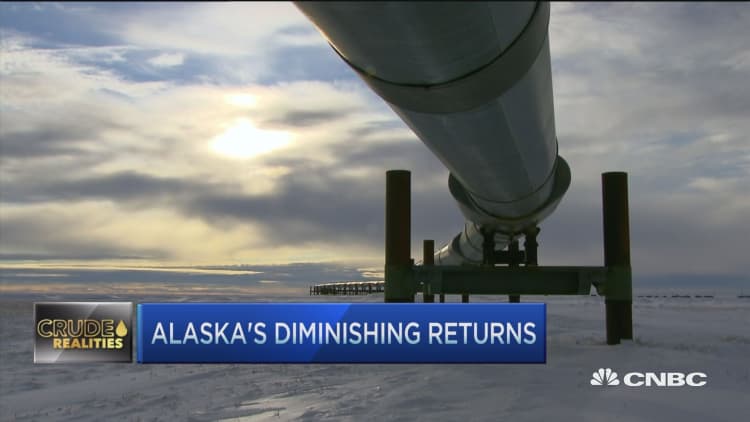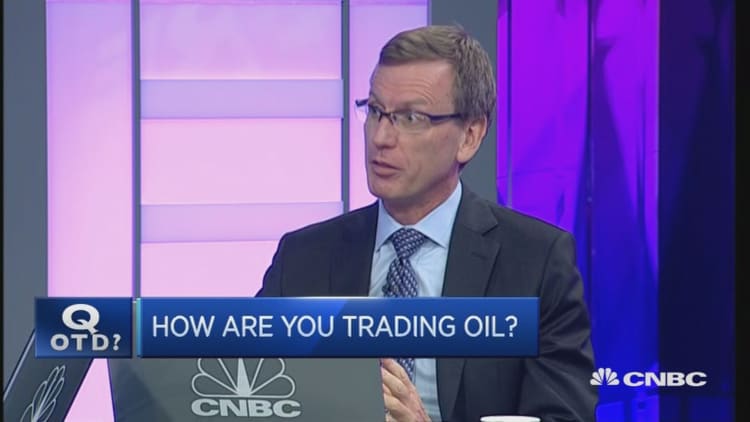
JUNEAU, Alaska — "Every Alaska governor spins the oil price wheel," joked the current governor, Bill Walker, during an interview in his office last month.
When predecessor Sarah Palin was in office, the wheel came up to $144.59 — the high price set by North Slope crude oil in July 2008, and the inspiration for Palin's chant during that year's presidential campaign: "Drill, baby, drill!"
Walker, an Independent, has not been so fortunate.
The price had already dropped to around $74 a barrel when he took office at the end of 2014. By this past Jan. 20, it plunged to a painfully low $26.23, according to the Alaska Department of Revenue. The price has rebounded a bit since then, but not nearly enough to get Walker — and the state — out of the mess in which they find themselves.
The Alaskan legislative session, which was scheduled to wrap up Sunday, has gone into overtime, with no end in sight. Walker and state lawmakers are trying to close a staggering $4.1 billion budget gap. To put that in perspective, total state spending last fiscal year was less than $14 billion.
"With the oil price coming down, there is no shock absorber for that," Walker said. "So it's very dramatic."
Historically, Alaska has relied on oil for as much as 90 percent of state revenue. The industry accounts for roughly a third of all jobs in the state. But now, even after a recent recovery has pushed prices to above $40 per barrel, producing oil in Alaska is solidly a money-losing proposition.
"For the North Slope, the average cost to produce a barrel of oil before we pay any tax, whether it's to the federal government or to the state government, is about $52 a barrel," said Kara Moriarty, president and CEO of the Alaska Oil and Gas Association, an industry trade group.
The result has been massive cutbacks by large and small oil companies. The state's largest oil producer, ConocoPhillips, has laid off about 10 percent of its Alaska workforce, Moriarty says. BP has cut employment by 17 percent. Royal Dutch Shell in September announced it would cease offshore exploration in Alaska "for the foreseeable future," while other companies are cutting back or delaying exploration projects.
"That's going to have a significant impact in both operations and production," Moriarty said.
Clogged artery
Production cuts are also creating enormous headaches for operators of the Trans Alaska Pipeline System, which transports oil from the North Slope, through 800 miles of some of the harshest conditions imaginable, to the port at Valdez.
Betsy Haines, an engineering supervisor for Alyeska Pipeline Services in Anchorage, said the line is running at about a quarter of its 2 million barrel-per-day capacity. That means that while it would normally take about four days for a barrel of oil to make the trip, it now takes about 18 days. That reduced flow creates some serious engineering challenges.
"Half of our line is above ground, half is below ground, and we go through some very cold areas in the winter," Haines said. "And there is some water in the crude oil, and there's this potential for ice."
Engineers have experimented with heating the line, but that doesn't address another effect of the low flow — difficult-to-detect globs of wax, a natural byproduct of the oil, that can coat the inside of the pipeline like plaque in an artery, potentially doing long-term damage to the line. Haines said that even if engineers can manage the issues, every solution costs money.
"I will tell you that I have woken up worried about the future end of the Trans Alaska Pipeline System because, again, it's not just technical, it's economic," Haines said.
As painful as all of this may seem, the governor told CNBC he remains optimistic.
"If we fix this once, when oil prices rise we don't need to change anything. It's all on the positive side," Walker said.
But exactly when oil prices will rise — and by how much — remains a multibillion dollar question here. Long term, there are proposals for a new pipeline from the North Slope, this one carrying natural gas. There is also perpetual talk of diversifying the state's economy. But that will take money, which — unlike oil — is in short supply here.
A new normal?
Alaskans have seen lower oil prices than these, and have always seen them rebound. But there appears to be a growing belief that this time is different — and could represent a new normal.
Not only is worldwide demand down and energy efficiency on the rise, but Alaska faces new competition from shale oil and improved technology like fracking. So the conversation in Juneau has focused on ways to reduce the state's dependence on oil, or at least its vulnerability to the changing price.
"What we have done as a state, we've said let's live off one commodity," Walker said. "So I say let's get off of this."
Walker's plan — which would be considered an act of political suicide in any other year and may still prove to be one this year — involves tapping into the state's already accumulated oil wealth, the $50 billion Alaska Permanent Fund. Established by a state constitutional amendment 40 years ago, the fund is also the source for annual dividends paid to every man, woman and child living in the state. Last year, those payments hit a record $2,072, meaning a family of five would collect a check of $10,360 just for living in Alaska. Under Walker's proposal, those payments would be reduced.



"I'd like to not see that go away," said Diane Antaya, a teacher in Juneau. "I see a lot of my students and families are very dependent upon it."
Indeed, the Permanent Fund Dividend is a major reason that despite rising income inequality nationwide, Alaska led the nation for equality, according to 2014 figures from the U.S. Census Bureau. But beyond that, the dividend plays a part in basic financial planning for nearly every Alaskan.
"I know that for my own child, it's going to help him get to college," Antaya said.
Republicans, who control both houses of the legislature, have proposed a similar restructuring of the fund, including dividend cuts, while guaranteeing a minimum annual payment of $1,000.
Balancing act
Walker says his plan, which uses earnings from the fund as an ongoing budget cushion, would move the state from 90 percent dependent on oil to around 21 percent. But he insists the plan does not work unless the state also raises or adds a broad array of taxes. That includes imposing a state income tax for the first time since 1980, which Republicans oppose.
Democrats, meanwhile, say that before individuals are hit, businesses must kick in — including reforms to the state's generous tax breaks for oil exploration.
"How are we going to fund schools? How are we going to help seniors? How are we going to help people with disabilities and build a state that people want to stay in?" asked Rep. Les Gara, who sits on the state House Finance Committee.
Indeed, state spending has already been drastically cut, and the head of the state's largest school system — the 48,500-student Anchorage School District — is bracing for things to get even worse.
"We're at a point now with this year, we're going to have to make reductions that are going to have a direct impact to the classroom," said Superintendent Ed Graff.
Walker's proposal would restructure the oil exploration credits and raise a host of business and corporate taxes. The oil industry says the package is the equivalent of kicking them while they're down.
"Raising taxes on the oil industry when we're already facing tough times only makes a bad situation even worse," said the oil and gas association's Moriarty. "We just need a stable, predictable fiscal system so that investors have confidence that Alaska's a good place to do business."
Other industries could feel the pain as well. The state House last week cleared the way for higher taxes on the $5.8 billion commercial fishing industry, which is demanding it not be singled out.
"We know that the state is ... having problems, and we're willing to step up to the plate, but we got to see what the total thing is going to be on the industry, which is a lot smaller than oil and gas," said Jerry McCune, president of United Fishermen of Alaska, which represents 35 commercial fishing organizations across the state.








